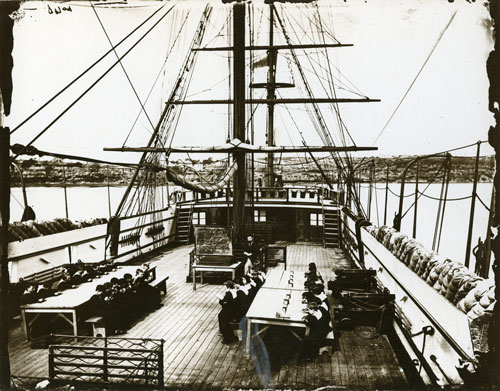Inner Sydney in the 1860s and the Industrial Schools Act
Inner Sydney in the 1860s and the Industrial Schools Act
In February, 1867, she was fitted up for a nautical school under the Industrial Schools Act of 1866, and inaugurated on the 17th of April, 1867. The first boys were received on board on the 20th of May the same year.
Since then 697 have passed through the books, and 452 have been apprenticed to various callings, principally as farm and general servants. The first apprentice went to sea and is still following that profession.
The demand for shore work, far exceeds that for the sea, unless the grown lads were permitted to join the navy, when all that are available would be taken up for that service. The majority of these apprenticed have turned out well ; some are in Queensland and Victoria, but generally scattered over New South Wales working for themselves. Nearly all the reports from masters who have apprentices are favourable.
The work of the ship commences in summer at 4.30 a.m., and in winter at 6 a.m ; breakfast at 7 a.m ; half the boys to school at 9 a.m., the other half to trades and ship's work ; dinner at noon. At 1 p.m. the half who were at work go to school, and those who were at school in the forenoon go to work, except on Wednesday forenoon, when there is general sail drill and on Saturdays clean ship.
On Sunday, weather permitting, two divisions of boys are landed and march to church, under the charge of officers; the Presbyterian Church send teachers in the afternoon for religious instruction to the Protestant boys. On Friday morning they are examined at the guns, and occasionally they are landed on Cockatoo and drilled with rifles
The Vernon
The photos (right) are from the Vernon around 1869 to 1875
The Vernon was located in the harbour near Cockatoo Island and involved the complete institutionalisation - including a structured curriculum of religious instruction, moral, industrial, and nautical training, as well as elementary schooling - aboard the ship
The boys had a garden on Cockatoo Island where they grew their own food. Their daily timetable consisted of schooling, training, drill and work with other structured time for sports and recreation and church on Sundays
Once the boys had demonstrated good character they were offered the opportunity for an apprenticeship. If this doesn't occur, they were released at 18
Whilst 2/3rd of the boys admitted ended up with apprenticeships as farm or general servants before the age of 18
School Lessons Vernon c.1869
Foot Drill Vernon c.1870s
